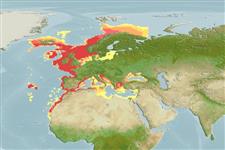Preferred temperature (Ref.
115969): 6.9 - 15.4, mean 10.2 (based on 672 cells).
Phylogenetic diversity index (Ref.
82804): PD
50 = 0.5000 [Uniqueness, from 0.5 = low to 2.0 = high].
Bayesian length-weight: a=0.00479 (0.00431 - 0.00531), b=3.12 (3.09 - 3.15), in cm Total Length, based on LWR estimates for this species (Ref.
93245).
Niveau trophique (Ref.
69278): 4.4 ±0.0 se; based on diet studies.
Résilience (Ref.
120179): Milieu, temps minimum de doublement de population : 1,4 à 4,4 années (K=0.07-0.3; tmax=20; Fecundity=7 million).
Prior r = 0.48, 95% CL = 0.32 - 0.72, Based on 34 full stock assessments.
Fishing Vulnerability (Ref.
59153): High to very high vulnerability (66 of 100).
Climate Vulnerability (Ref.
125649): Moderate vulnerability (39 of 100).
